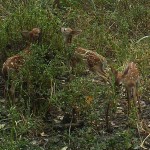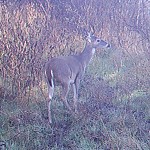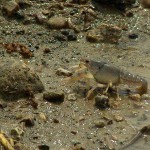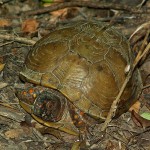This is the first buck I have photographed at Old Alton Bridge Park. It looks like a nice one.

Here is what Wikipedia has to say about White-tailed Deer:
Males re-grow their antlers every year. About 1 in 10,000 females also have antlers, although this is usually associated with hermaphroditism. Bucks without branching antlers are often termed “Spikehorn”, “spiked bucks”, “spike bucks” or simply “spike”. The spikes can be quite long or very short. Length and branching of antlers is determined by nutrition, age, and genetics. Rack growth tends to be very important from late spring until about a month before velvet sheds. During this time frame damage that may be done to the racks tends to be permanent. Healthy deer in some areas that are well fed can have eight-point branching antlers as yearlings (one and a half years old). The number of points, the length or thickness of the antlers are a general indication of age but cannot be relied upon for positive aging. A better indication of age is the length of the snout and the color of the coat, with older deer tending to have longer snouts and grayer coats. Some say that deer that have spiked antlers should be culled from the population to produce larger branching antler genetics (antler size does not indicate overall health), and some bucks’ antlers never will be wall trophies. Where antler growth nutritional needs are met (good mineral sources, i.e., calcium) and good genetics combine it can produce wall trophies in some of their range. Spiked bucks are different from “button bucks” or “nubbin’ bucks”, that are male fawns and are generally about six to nine months of age during their first winter. They have skin covered nobs on their heads. They can have bony protrusions up to a half inch in length, but that is very rare, and they are not the same as spikes.






